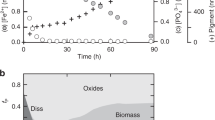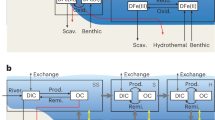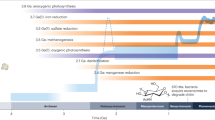Abstract
Photosynthesis produces reduced organic carbon and an oxidized partner in equivalent molar amounts. These compounds can react with one another, again in equivalent molar amounts, so that no net change occurs in the overall level of oxidation of the biosphere (here taken to mean the biota together with the part of the Earth with which living things interact1). But, the reduced and oxidized partners have different susceptibilities to transport by environmental processes and so, typically, they become separated. Conservation of matter implies that for every mole of excess oxidant in an oxidizing region of the biosphere there must be a mole of excess reductant in a reducing region. Today, the oxidized partner in photosynthesis is usually free oxygen, which floats upward to accumulate in excess in the atmosphere, whereas organic matter settles downward to collect in sediments and stagnant pools. On the anoxic Archaean Earth, the oxidized partner was probably iron. As oxidized iron is markedly less soluble and mobile than organic carbon, differential transport in the Archaean biosphere would have had an effect just the opposite of that in the modern biosphere. The oxidized partner would have settled downward more rapidly than the reduced partner, resulting in the accumulation of excess oxidant in sediments and stagnant pools/An equivalent excess of the more volatile reduced compounds would have been left behind in ocean and atmosphere in the form of dissolved organic carbon and gaseous hydrocarbons. On average, therefore, the Archaean biosphere may have been oxidizing at the bottom and reducing on top.
This is a preview of subscription content, access via your institution
Access options
Subscribe to this journal
Receive 51 print issues and online access
$199.00 per year
only $3.90 per issue
Buy this article
- Purchase on Springer Link
- Instant access to full article PDF
Prices may be subject to local taxes which are calculated during checkout
Similar content being viewed by others
References
Valentine, J. W. Evolutionary Paleoecology of the Marine Biosphere (Prentice-Hall, Englewood Cliffs, 1973).
Schopf, J. W. (ed.) in Earth's Earliest Biosphere: Its Origin and Evolution (Princeton University Press, 1983).
Walker, J. C. G. & Brimblecombe, P. Precambr. Res. 28, 205–222 (1985).
Froelich, P. N. et al. Geochim. cosmochim. Acta 43, 1075–1090 (1979).
Cloud, P. Econ. Geol. 68, 1135–1143 (1973).
Cameron, E. M. & Garrels, R. M. Chem. Geol. 28, 181–197 (1980).
Gole, M. J. & Klein, C. J. Geol. 89, 169–183 (1981).
Walker, J. C. G. et al. in Earth's Earliest Biosphere: Its Origin and Evolution (ed. Schopf, J. W.) 260–290 (Princeton University Press, 1983).
Walker, J. C. G. Nature 309, 340–342 (1984).
Baur, M. E., Hayes, J. M., Studley, S. A. & Walter, M. R. Econ. Geol. 80, 270–282 (1985).
Kasting, J. F., Zahnle, K. J. & Walker, J. C. G. Precambr. Res. 20, 121–148 (1983).
Author information
Authors and Affiliations
Rights and permissions
About this article
Cite this article
Walker, J. Was the Archaean biosphere upside down?. Nature 329, 710–712 (1987). https://doi.org/10.1038/329710a0
Received:
Accepted:
Issue Date:
DOI: https://doi.org/10.1038/329710a0
Comments
By submitting a comment you agree to abide by our Terms and Community Guidelines. If you find something abusive or that does not comply with our terms or guidelines please flag it as inappropriate.



